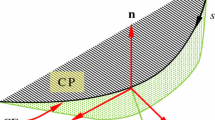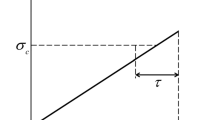Abstract
The initiation of crack growth under a combination of opening and anti-plane shearing mode loading is considered in this paper. It is shown that such cracks do not grow through a continuous evolution of the crack surface. Rather, an abrupt fragmentation or segmentation of the crack front is generated. Through experimental observations and a theoretical model, we postulate a relationship between the scale of the fragmentation and the mode mix.
Similar content being viewed by others
References
Amestoy M, Leblond JB (1992) Crack paths in plane situations: II detailed form of the expansion of the stress intensity factors. Int J Solids Struct 29: 465–501
Bonamy D, Ravi-Chandar K (2003) Interaction of stress waves with propagating cracks. Phys Rev Lett 91 (Art. No. 235502)
Bonamy D, Ravi-Chandar K (2005) Dynamic crack response to a localized shear pulse perturbation in brittle amorphous materials: on crack surface roughening. Int J Fract 134(2005): 1–22
Cooke ML, Pollard DD (1996) Fracture propagation paths under mixed mode loading within rectangular blocks of polymethyl methacrylate. J Geophys Res 101: 3387–3400
Davenport JCW, Smith DJ (1993) A study of superimposed fracture modes I, II and III on PMMA. Fatigue Fract Engng Mater Struct 16: 1125–1133
Gao H (1992) Three-dimensional slightly nonplanar cracks. J Appl Mech 59: 335–343
Gao H, Rice JR (1986) Shear stress intensity factors for a planar crack with slightly curved front. J Appl Mech 53: 774
Goldstein RV, Salganik RL (1974) Brittle fracture of solids with arbitrary cracks. Int J Frac 10: 507–523
Hodogdon JA, Sethna JP (1993) Derivation of a general 3-dimensional crack-propagation law—A generalization of the principle of local symmetry. Phys Rev B 47: 4831–4840
Hull D (1993) Tiltig cracks: the evolution of fracture surface topology in brittle solids. Int J Fract 62: 119–138
Hull D (1995) The effect of mixed mode I/III on crack evolution in brittle solids. Int J Fract 70: 59–79
Knauss WG (1970) An observation of crack propagation in anti-plane shear. Int J Frac 6: 183–187
Lazarus V, Buchholz FG, Fulland M, Wiebesiek J (2008) Comparison of predictions by mode II or mode III criteria on crack front twisting in three or four point bending experiments. Int J Fract 153: 141–151
Lazarus V, Leblond JB (2001a) Crack front rotation and segmentation in mixed mode I + III or I + II + III. Part I: calculation of stress intensity factors. J Mech Phys Solids 49: 1399–1420
Lazarus V, Leblond JP (2001b) Crack front rotation and segmentation in mixed mode I + III or I + II + III. Part II: comparison with experiments. J Mech Phys Solids 49: 1421–1443
Li S, Mear ME (1998) Singularity-reduced integral equations for displacement discontinuities in three-dimensional linear elastic media. Int J Fract 93: 87–114
Li S, Mear ME, Xiao L (1998) Symmetric weak-form integral equation method for three dimensional fracture analysis. Comput Methods Appl Mech Engrg 151: 435–459
Movchan AB, Gao H, Willis JR (1998) On perturbations of plane cracks. Int J Solids Struct 35: 3419–3453
Murakami Y (1987) Stress intensity factors handbook. Pergamon, Oxford
Pollard DD, Segall PE, Delaney PT (1982) Formation and interpretation of dilatant echelon cracks. Geol Soc Am Bull 93: 1291–1303
Raju IS, Newman JC (1977) Three-dimensional finite-element analysis of finite-thickness fracture specimens, Technical Report NASA TND-8414, NASA Langley Research Center, Hampton, VA 23665
Schroth JG, Hirth JP, Hoagland RG, Rosenfeld AR (1987) Combined mode-I-mode-III fracture of a high strength low alloy steel. Met Trans 18A: 1061–1072
Smekal A (1953) Zum Bruchvogang bei sprodem Stoffrerhalten unter ein und mehrachsiegen Beanspringen. Osterr Ing Arch 7: 49–70
Sommer E (1969) Formation of fracture ‘lances’ in glass. Eng Frac Mech 1: 539–546
Sukumar N, Moes N, Moran B, Belytschko T (2000) Extended finite element method for three-dimensional crack modeling. Int J Numer Methods Engrg 48: 1549–1570
Xu G, Bower AF, Ortiz M (1994) An analysis of non-planar crack growth under mixed mode loading. Int J Solids Struct 31: 2167–2193
Yates JR, Miller KJ (1989) Mixed-mode (I–III) fatigue thresholds in a forging steel. Fatigue Fract Eng Mater and Struct 12: 259–270
Author information
Authors and Affiliations
Corresponding author
Rights and permissions
About this article
Cite this article
Lin, B., Mear, M.E. & Ravi-Chandar, K. Criterion for initiation of cracks under mixed-mode I + III loading. Int J Fract 165, 175–188 (2010). https://doi.org/10.1007/s10704-010-9476-7
Received:
Accepted:
Published:
Issue Date:
DOI: https://doi.org/10.1007/s10704-010-9476-7




